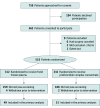Prothrombin Complex Concentrate vs Plasma for Post-Cardiopulmonary Bypass Coagulopathy and Bleeding: A Randomized Clinical Trial
- PMID: 35767271
- PMCID: PMC9244769
- DOI: 10.1001/jamasurg.2022.2235
Prothrombin Complex Concentrate vs Plasma for Post-Cardiopulmonary Bypass Coagulopathy and Bleeding: A Randomized Clinical Trial
Abstract
Importance: Post-cardiopulmonary bypass (CPB) coagulopathy and bleeding are among the most common reasons for blood product transfusion in surgical practices. Current retrospective data suggest lower transfusion rates and blood loss in patients receiving prothrombin complex concentrate (PCC) compared with plasma after cardiac surgery.
Objective: To analyze perioperative bleeding and transfusion outcomes in patients undergoing cardiac surgery who develop microvascular bleeding and receive treatment with either PCC or plasma.
Design, setting, and participants: A single-institution, prospective, randomized clinical trial performed at a high-volume cardiac surgical center. Patients were aged 18 years or older and undergoing cardiac surgery with CPB. Patients undergoing complex cardiac surgical procedures (eg, aortic replacement surgery, multiple procedures, or repeated sternotomy) were preferentially targeted for enrollment. During the study period, 756 patients were approached for enrollment, and 553 patients were randomized. Of the 553 randomized patients, 100 patients met criteria for study intervention.
Interventions: Patients with excessive microvascular bleeding, a prothombin time (PT) greater than 16.6 seconds, and an international normalized ratio (INR) greater than 1.6 were randomized to receive treatment with either PCC or plasma. The PCC dose was 15 IU/kg or closest standardized dose; the plasma dose was a suggested volume of 10 to 15 mL/kg rounded to the nearest unit.
Main outcomes and measures: The primary outcome was postoperative bleeding (chest tube output) from the initial postsurgical intensive care unit admission through midnight on postoperative day 1. Secondary outcomes were PT/INR, rates of intraoperative red blood cell (RBC) transfusion after treatment, avoidance of allogeneic transfusion from the intraoperative period to the end of postoperative day 1, postoperative bleeding, and adverse events.
Results: One hundred patients (mean [SD] age, 66.8 [13.7] years; 61 [61.0%] male; and 1 [1.0%] Black, 1 [1.0%] Hispanic, and 98 [98.0%] White) received the study intervention (49 plasma and 51 PCC). There was no significant difference in chest tube output between the plasma and PCC groups (median [IQR], 1022 [799-1575] mL vs 937 [708-1443] mL). After treatment, patients in the PCC arm had a greater improvement in PT (effect estimate, -1.37 seconds [95% CI, -1.91 to -0.84]; P < .001) and INR (effect estimate, -0.12 [95% CI, -0.16 to -0.07]; P < .001). Fewer patients in the PCC group required intraoperative RBC transfusion after treatment (7 of 51 patients [13.7%] vs 15 of 49 patients [30.6%]; P = .04); total intraoperative transfusion rates were not significantly different between groups. Seven (13.7%) of 51 patients receiving PCCs avoided allogeneic transfusion from the intraoperative period to the end of postoperative day 1 vs none of those receiving plasma. There were no significant differences in postoperative bleeding, transfusions, or adverse events.
Conclusions and relevance: The results of this study suggest a similar overall safety and efficacy profile for PCCs compared with plasma in this clinical context, with fewer posttreatment intraoperative RBC transfusions, improved PT/INR correction, and higher likelihood of allogeneic transfusion avoidance in patients receiving PCCs.
Trial registration: ClinicalTrials.gov Identifier: NCT02557672.
Conflict of interest statement
Figures


Comment in
-
Prothrombin Complex Concentrate and Cardiac Surgery.JAMA Surg. 2023 Feb 1;158(2):222-223. doi: 10.1001/jamasurg.2022.5801. JAMA Surg. 2023. PMID: 36449283 No abstract available.
-
Prothrombin Complex Concentrate and Cardiac Surgery-Reply.JAMA Surg. 2023 Feb 1;158(2):223-224. doi: 10.1001/jamasurg.2022.5802. JAMA Surg. 2023. PMID: 36449296 No abstract available.
-
Prothrombin Complex Concentrate and Cardiac Surgery.JAMA Surg. 2023 Feb 1;158(2):222. doi: 10.1001/jamasurg.2022.5800. JAMA Surg. 2023. PMID: 36449305 No abstract available.
References
Publication types
MeSH terms
Substances
Associated data
LinkOut - more resources
Full Text Sources
Medical
Miscellaneous

